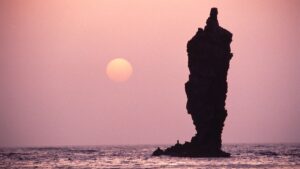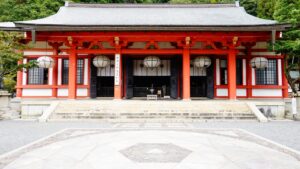Kiyomizu-dera Temple, Kannon Brought Victory to a Noble Warrior, Tamuramaro
Kiyomizu-dera Temple recognized as one of the Historic Monuments of Ancient Kyoto and a World Cultural Heritage site, was established halfway up Mt. Otowa in 778, merely six years before the capital relocation from Nara’s Heijo-kyo. The main image is the Eleven-headed Thousand-armed Kannon Bodhisattva, revered for aiding people from difficulties. The most enchanting feature of Kiyomizu-dera Temple unveils itself from the stage suspended in front of the Main Hall. Comprising approximately 410 cypress boards, the stage is equivalent in size to about 100 tatami mats (or 190 square meters). It is on this stage that various performing arts, including Noh and Kabuki, are dedicated to the Kannon (Goddess of Mercy) enshrined in the main hall.
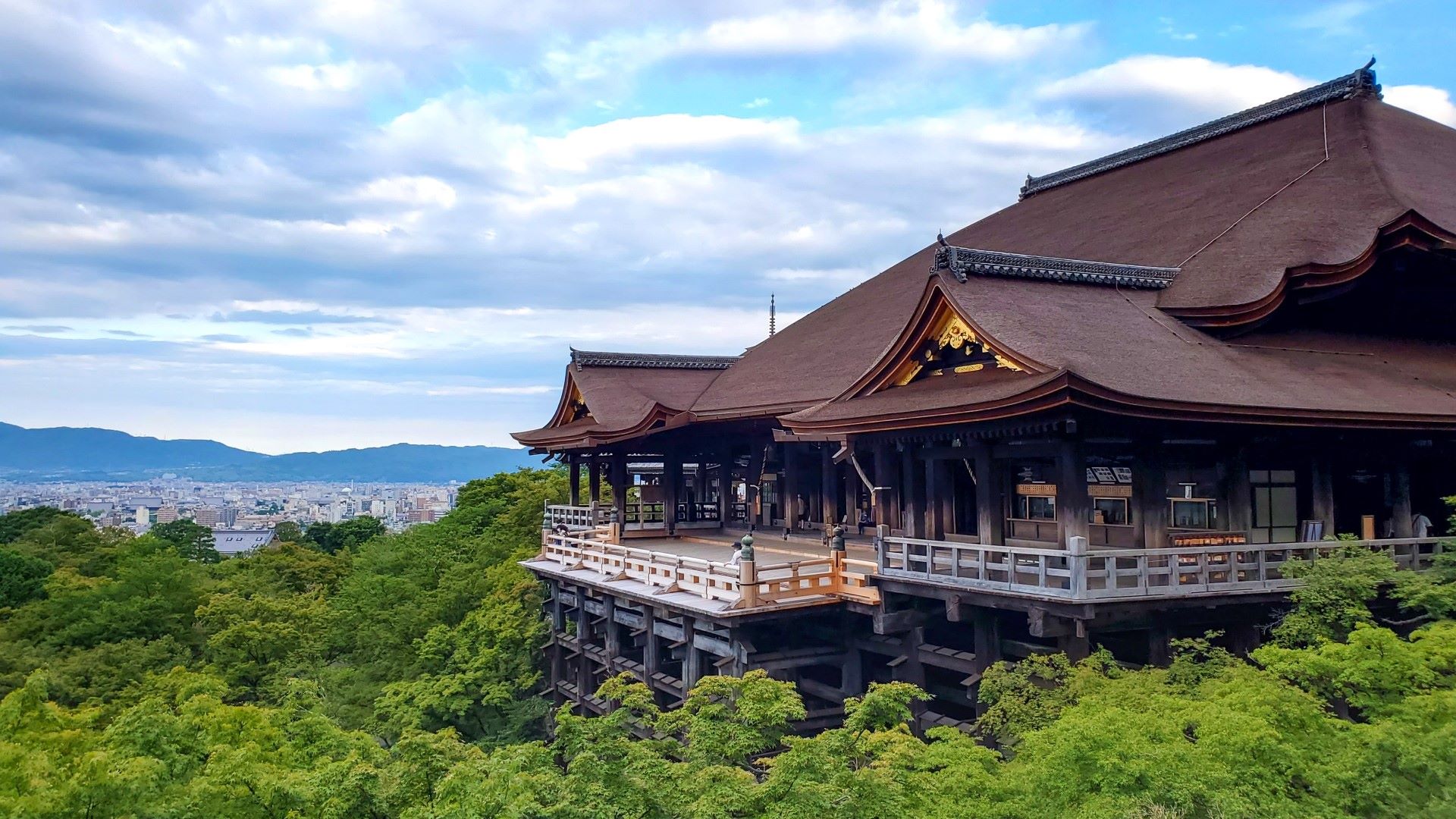
The Noh play, Tamura
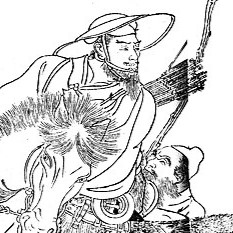
One spring day, a monk from an eastern province visited Kiyomizu-dera Temple and encountered a boy holding a broom. When the monk inquired about the history of Kiyomizu-dera Temple, the boy began recounting that it was built by Shogun, Sakanoue-no-Tamuramaro (758-811, 坂上田村麻呂). While a fleeting moment, the boy and monk relished the cherry blossoms of Kiyomizu-dera Temple. At night, during the monk recited the Lotus Sutra, the spirit of Tamuramaro, adorned in warrior attire, materialized in the dimness and started to talk, "I was appointed Shogun to conquer the enemy to secure the nation. Thus, I offered prayers for Kannon’s support with my forces. With gratitude for the power of Kannon, I successfully defeated the enemies."
The main attractions are the beauty of a spring evening adorned with cherry blossoms and moonlight at Kiyomizu-dera Temple, where a boy embodying the incarnation of Tamuramaro appears. In addition, the narrative unfolds the triumph and celebration of Tamuramaro, who is associated with the founding of Kiyomizu-dera Temple, as he overcomes his enemies with the blessing of Kannon's divine power.
Tohoku on the eve of the appearance of Shogun, Tamuramaro
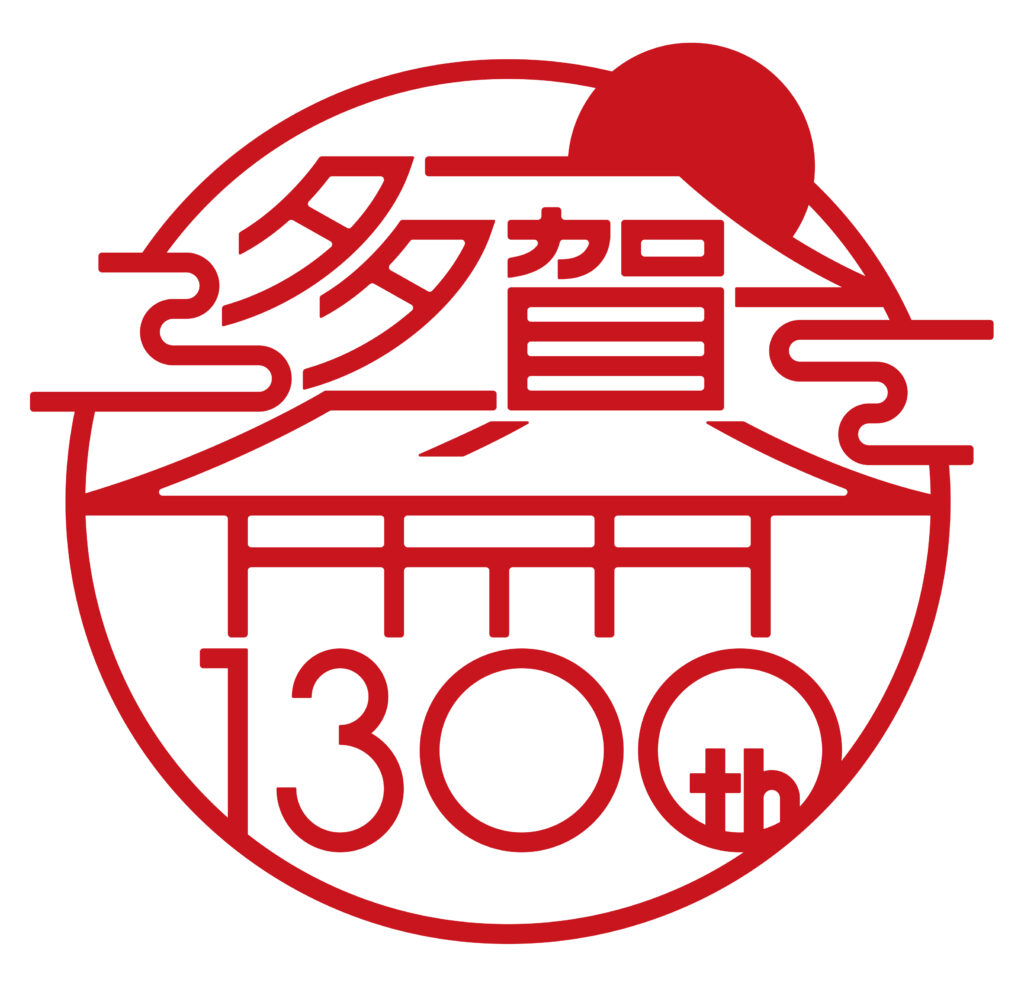
After the completion of the Taiho Ritsuryo Code in 701, the Yamato Imperial Court promoted the establishment of the nation based on the Ritsuryo Code. For this, in 708, Emperor Genmei issued an imperial order to relocate the capital from Asuka to Heijo-kyo, situated in the heart of Nara - a vast capital city spanning 2,500 hectares. Construction began in 709. Shortly thereafter, a rebellion by the Emishi (barbarian tribes) erupted in the undeveloped Tohoku region. The Imperial Court dispatched a Shogun to quell the rebellion and appointed officials to address the Tohoku residents who opposed the Imperial Court, constructing fortresses and fences. In 724, the Imperial Court established Taga Castle (Taga Fence) as a stronghold in the northeast to fortify and govern the Tohoku region.
During a period marked by frequent natural disasters and epidemics, the following emperor, Emperor Shomu (701-756, 聖武天皇), initiated the construction of the Great Buddha at Todaiji Temple, seeking to alleviate the plight of the people through the power of Buddhism. However, acquiring substantial gold for the Great Buddha statue’s construction proved challenging. Fortunately, the discovery of a gold vein in Tohoku in 749 facilitated the successful completion of the Great Buddha. To bolster its economic power, the Imperial Court intensified its control over the Tohoku region.
The Holy War of Aterui, the leader of Emishi, echoed through the mountains and rivers
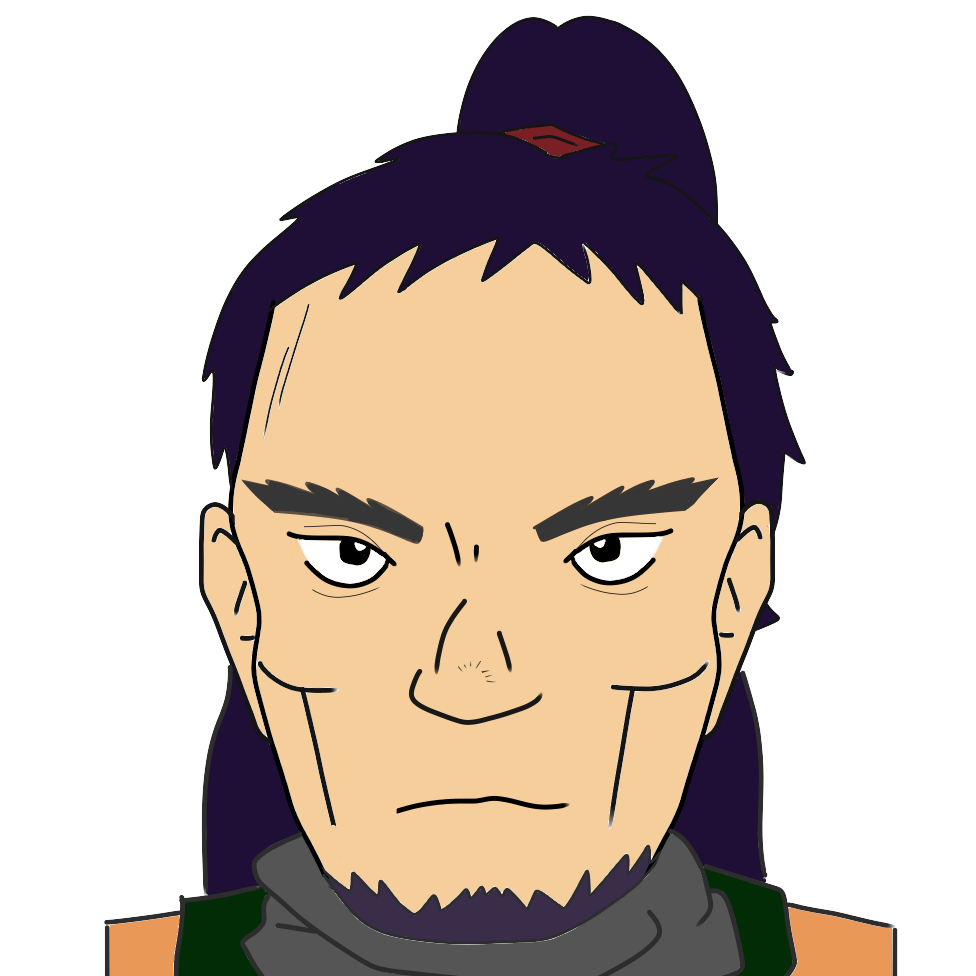
As the Imperial Court forces, numbering over 50,000 men, expanded their territory into the Tohoku region, Aterui (Late 8th to early 9th century, 阿弖流為), the leader of the Emishi, emerged to defend the Tohoku homeland. The Emishi army, under Aterui’s command, constituted only one-tenth of the total Imperial Court forces. Despite the numerical disadvantages, Aterui strategically utilized the geographical features, dispersing the large Imperial Army, enticing them into a defile, and employing guerrilla warfare tactics to secure victory in battle. The resonance of this conflict echoed through the mountains and rivers, perpetuating the high morale of the Emishi warriors as the holy war persisted.
Shogun, Sakanoue-no-Tamuramaro is sent to conquer the Emishi
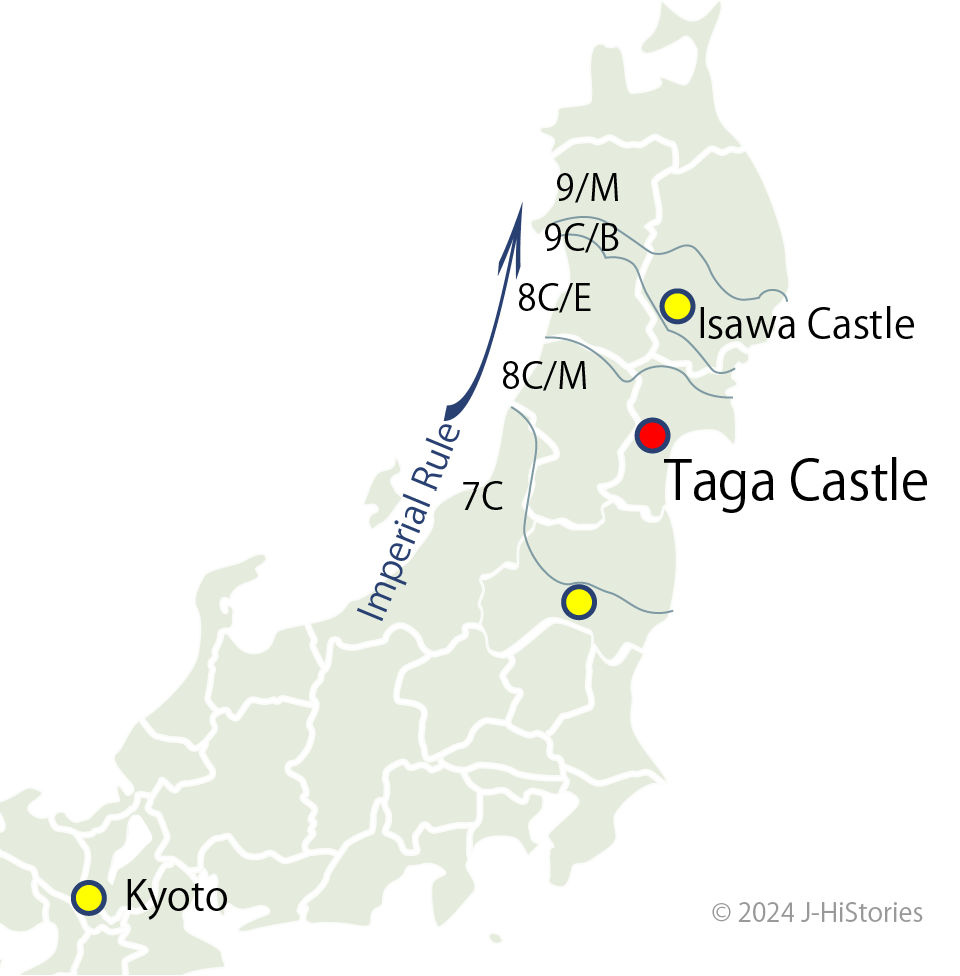
Faced with the challenge of subduing the Emishi, Emperor Kanmu appointed Sakanoue-no-Tamuramaro as the barbarian general and dispatched a formidable army of 100,000 men to conquer the region. Tamuramaro, in a gesture of dedication, donated his house, contributed to the construction of Kiyomizu-dera Temple, and is reputed to have sought victory through prayers to Kannon (although an alternate theory exists). After 13 years of conflict, in 801, Aterui and co-leader, More, surrendered, along with his second-in-command. Tamuramaro petitioned the Imperial Court to spare Aterui's life as a practical approach to governing the Tohoku region, but unfortunately, both were executed. In the reign of Emperor Kanmu during the Nara and early Heian periods, Tamuramaro contributed greatly to the pacification of the Emishi in Tohoku, playing a key role in achieving national unity. Additionally, Tamuramaro quelled the Kusuko Incident during the reign of Emperor Kanmu's son, Emperor Saga, earning immense trust from the Imperial Court. He ultimately concluded his military career at the age of 54.
Amazing “Kake-zukuri” Architecture on a cliff
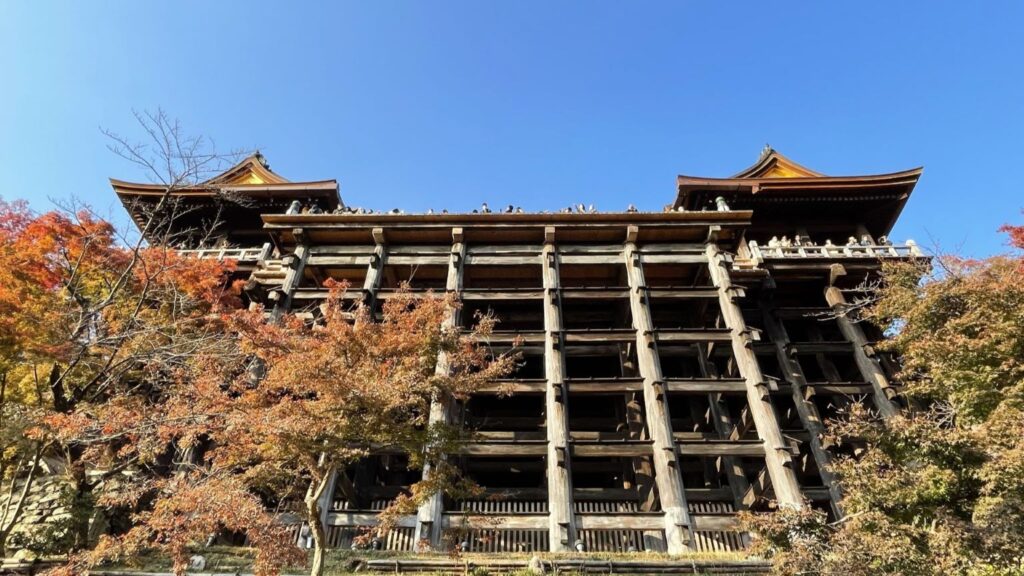
Descending the stairs from the stage, on your right side, you’ll notice that it’s constructed on a cliff supported by 18 poles made from over 400-year-old zelkova. Several cypress poles crisscross them horizontally without being fixed by nails. This architectural technique is known as “Kake-zukuri” or the overhang method, designed to resist earthquakes when built on a cliff. The structure’s ability to withstand weathering, particularly from rainfall, is equally significant in its design. The stage is slightly inclined to facilitate rainwater drainage into the ground. Each protruding end of the wooden beams is equipped with small wooden roofs to shield the wood from rain.
Aterui, The Brave of the Northern Sky

On the way to the Sanmon Gate, with the beauty of the kake-zukuri technique behind you, a memorial monument dedicated to Aterui and More stands on the left side. Inscribed with the words "Brave of the Northern Sky," this monument pays homage to Tamuramaro and Aterui, two formidable warriors who engaged in sword duels in the Tohoku region during the Heian period.
Sakanoue-no-Tamuramaro Timeline
| 710 | Relocation of the capital to Heijo-kyo in Nara from Asuka | - | Nara Period |
| 743 | Todaiji Great Buddha construction started till 752 | - | |
| 749 | Emperor Shomu abdicated from the throne | - | |
| 758 | Sakanoue-no-Tamuramaro was born | Age=1 | |
| 778 | Kiyomizu-dera was established | 21 | |
| 780 | Sananoue-no-Tamuramaro donated his house to Kiyomizu-dera | 23 | |
| 781 | Emperor Kanmu was throned | 24 | |
| 791 | Sakanoue-no-Tamuramaro deployed to Tohoku | 34 | |
| 794 | The relocation of the capital to the city to Heian-kyo in Kyoto | 37 | Heian Period |
| 794 | Sakanoue-no-Tamuramaro conqured Emishi | 37 | |
| 797 | Sakanoue-no-Tamuramaro was appointed Shogun | 40 | |
| 801 | Sakanoue-no-Tamuramaro deploed to Tohoku | 44 | |
| 802 | Sakanoue-no-Tamuramaro started to build Isawa Castle | 45 | |
| 802 | Aterui fell to the Imperial Army and was ecuted | 45 | |
| 806 | Emperor Kanmu passed away, Emperor Heizei ascended the throne | 49 | |
| 809 | Emperor Heizei abdicated and Emperor Saga ascended the throne | 52 | |
| 810 | Kusuko incident occurred | 53 | |
| 811 | Sakanoue-no-Tamuramaro passed away | 54 |
Recommendations to visit
Kiyomizu-dera Temple
- Access: Get on #206 bus bound for Kitaoji bus terminal (北大路バスターミナル) via Higasihama-dori or #100 bound for Ginkaku-ji (銀閣寺) via Kiyomizu-dera Gion at Kyoto Station. Get off at Gojozaka stop (五条坂) and a 10-minute walk.

